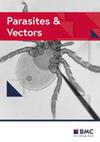Helminth co-infections have no additive detrimental impact on milk yield and milk quality compared to mono-infections in German dairy cows
IF 3
2区 医学
Q1 PARASITOLOGY
引用次数: 0
Abstract
Infections with (tricho-)strongyles, Dictyocaulus viviparus or Fasciola hepatica have been shown to reduce milk production in dairy cows. However, the current published studies focused on one single helminth infection by neglecting helminth co-infections and their possible (additive) effects on host performance. Hence, for the first time, we investigated differences in the impact of patent helminth co-infections versus mono-infections on milk production parameters in individual cows. A total of 1583 dairy cows from 27 herds were included in this study. Faecal samples were examined in 2015 and 2021/2022 to determine the number of eggs/larvae per gram faeces for (tricho-)strongyles, D. viviparus, F. hepatica and rumen flukes. The cows were classified as non-infected, mono-infected and co-infected. Linear mixed models were applied to analyse the association between infection status (non-infected vs. mono-infected vs. co-infected) with milk yield, milk protein and milk fat content by including potential confounders. Infections with (tricho-)strongyles, D. viviparus, F. hepatica and rumen flukes were detected in 100%, 28.6%, 50.0% and 21.4% of herds, and 27.4%, 2.6%, 10.8% and 0.8% of faecal samples in 2015, while 100%, 0.0%, 86.7% and 60.0% of herds and 52.3%, 0.0%, 13.3% and 26.8% of faecal samples were positive in 2021/2022. Co-infections with two or more helminth taxa were detected in 74.4% of herds and 5.0% of faecal samples in 2015, and in 93.3% of herds and 21.7% of faecal samples in 2021/2022. The correlations between strongyle EPG, D. viviparus LPG and F. hepatica EPG were significantly positive in 2015. Significantly higher mean EPGs were identified in 2015 in faecal samples presenting co-infections with F. hepatica and one or two other helminth taxa than in faecal samples presenting F. hepatica mono-infections (P = 0.013). Although expected, the infection status (mono- or co-infected) had no significant impact on milk yield, milk protein and milk fat content in the linear mixed model analyses based on individual faecal examinations. Patent helminth co-infections had no additive detrimental impact on milk production parameters in the present study. This might be a result of presumably low worm burdens, but should be confirmed in future studies.在德国奶牛中,与单一感染相比,螺旋体合并感染对奶牛的产奶量和牛奶质量没有额外的不利影响
研究表明,奶牛感染(三)强线虫、Dictyocaulus viviparus或Fasciola hepatica会降低产奶量。然而,目前已发表的研究主要集中在一种单一的蠕虫感染上,而忽略了蠕虫合并感染及其对宿主表现可能产生的(叠加)影响。因此,我们首次研究了专利蠕虫共感染与单一感染对奶牛产奶量参数影响的差异。本研究共纳入了来自 27 个牧场的 1583 头奶牛。在 2015 年和 2021/2022 年对粪便样本进行了检测,以确定每克粪便中(三代)强直球虫、D. viviparus、F. hepatica 和瘤胃吸虫的虫卵/幼虫数量。奶牛被分为未感染、单一感染和混合感染。采用线性混合模型分析感染状态(未感染 vs. 单一感染 vs. 共同感染)与产奶量、乳蛋白和乳脂肪含量之间的关系,并将潜在的混杂因素考虑在内。2015年,100%、28.6%、50.0%和21.4%的牛群以及27.4%、2.6%、10.8%和0.8%的粪便样本检测到(三代)强直球虫、D. viviparus、F. hepatica和瘤胃吸虫感染,而2021/2022年,100%、0.0%、86.7%和60.0%的牛群以及52.3%、0.0%、13.3%和26.8%的粪便样本检测到阳性。2015年,74.4%的畜群和5.0%的粪便样本检测到两种或两种以上蠕虫类群的共感染,2021/2022年,93.3%的畜群和21.7%的粪便样本检测到共感染。2015 年,强蛲虫 EPG、D. viviparus LPG 和 F. hepatica EPG 之间的相关性显著为正。2015 年,在同时感染肝包虫和一种或两种其他蠕虫类群的粪便样本中,EPG 平均值明显高于只感染肝包虫的粪便样本(P = 0.013)。尽管在意料之中,但在基于个体粪便检查的线性混合模型分析中,感染状态(单一感染或混合感染)对产奶量、乳蛋白和乳脂肪含量没有显著影响。在本研究中,专利螺旋体合并感染对牛奶产量参数没有额外的不利影响。这可能是由于蠕虫负担较低所致,但应在今后的研究中加以证实。
本文章由计算机程序翻译,如有差异,请以英文原文为准。
求助全文
约1分钟内获得全文
求助全文
来源期刊

Parasites & Vectors
医学-寄生虫学
CiteScore
6.30
自引率
9.40%
发文量
433
审稿时长
1.4 months
期刊介绍:
Parasites & Vectors is an open access, peer-reviewed online journal dealing with the biology of parasites, parasitic diseases, intermediate hosts, vectors and vector-borne pathogens. Manuscripts published in this journal will be available to all worldwide, with no barriers to access, immediately following acceptance. However, authors retain the copyright of their material and may use it, or distribute it, as they wish.
Manuscripts on all aspects of the basic and applied biology of parasites, intermediate hosts, vectors and vector-borne pathogens will be considered. In addition to the traditional and well-established areas of science in these fields, we also aim to provide a vehicle for publication of the rapidly developing resources and technology in parasite, intermediate host and vector genomics and their impacts on biological research. We are able to publish large datasets and extensive results, frequently associated with genomic and post-genomic technologies, which are not readily accommodated in traditional journals. Manuscripts addressing broader issues, for example economics, social sciences and global climate change in relation to parasites, vectors and disease control, are also welcomed.
 求助内容:
求助内容: 应助结果提醒方式:
应助结果提醒方式:


